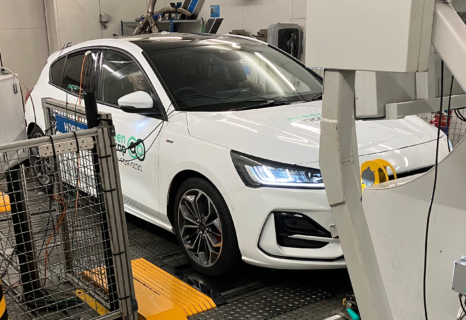Ford Focus 1.0 EcoBoost Mild Hybrid petrol FWD manual
2022
46%
4.5
10
Clean Air Index
5.3
10
Energy Efficiency Index
4.0
10
Greenhouse Gas Index
| Laboratory Tests | NMHC | NOX | NH3 | CO | PN | |
|---|---|---|---|---|---|---|
| 3.610 | Cold Test | |||||
| 7.210 | Warm Test | |||||
| 0.010 | Highway | |||||
| Cold Ambient Test | Does not qualify for additional robustness testing | |||||
| Road Test | ||||||
| 6.710 | On-Road Drive | |||||
| 2.85 | On-Road Short Trip | |||||
| On-Road Heavy Load | Does not qualify for additional robustness testing | |||||
| On-Road Light Load | Does not qualify for additional robustness testing | |||||
| Congestion | Does not qualify for additional robustness testing | |||||
| Laboratory Tests | Energy | |||
|---|---|---|---|---|
| 5.810 | Cold Test | |||
| 6.110 | Warm Test | |||
| 4.310 | Highway | |||
| Cold Ambient Test | Does not qualify for additional robustness testing | |||
| Consumption | Driving Range | |||
| Average | 6.1l100 km | 868km | ||
| Worst-Case | 6.9l100 km | 750km | ||
| Greenhouse Gases | CO2 | N2O | CH4 | |
|---|---|---|---|---|
| 4.610 | Cold Test | |||
| 4.910 | Warm Test | |||
| 2.710 | Highway | |||
| Cold Ambient Test | Does not qualify for additional robustness testing | |||
Specifications
- Tested Car WF0NXXGCHNNL3XXXX
- Publication Date 12 2022
- Vehicle Class Small Family Car
- Emissions Class Euro 6d AP
- Tyres 235/40 R18
- Mass 1,355 kg
- Engine Size 999 cc
- Power/Torque 114 kW/190 Nm
- Declared CO2 122 g/km
- Declared Consumption 5.4 l/100 km







































































































































Our verdict
Tested here is the Ford Focus, equipped with the 1 liter Ecoboost petrol engine with 114 kW, 48V hybrid system and a manual transmission. With its design and functionality, the car appeals to a broad audience and continues the popularity of its Focus predecessors. The fuel consumption results do not surprise and are on a standard level, allowing consumers to cover most drives with 6‑7 l/100 km, whereas Short Urban Trips are expected to require more. With 5.3/10, the car collects a bit more than half of the available points in the Energy Efficiency Index. The emitted greenhouse gases need to be summed up with the emissions related to the production and supply of the petrol fuel and result in figures which are enough for a Greenhouse Gas Index of 4/10. The exhaust aftertreatment works well in the Warm laboratory test, but loses robustness when starting with cold powertrain or under high power demanding conditions. Addressing the weak spots of pollutants control would help the Focus easily reach more than the current Weighted Overall Index of 4.6 and earn more than the 2½ stars.